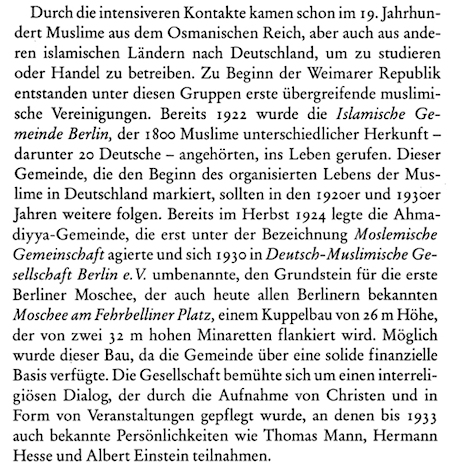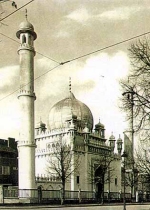Prominent historical visitors to the Berlin Mosque
Including Nobel laureates Albert Einstein, Thomas Mann and Hermann Hesse
The German daily newspaper Der Tagesspiegal published a large-spread feature entitled Berlin in den 20er jahren or ‘Berlin in the 1920s’ in its issue for 1st October 2017. It contained an item about the Berlin Mosque reproduced from 23 March 1929 entitled Halbmond über Wilmersdorf or ‘Crescent over Wilmersdorf’.
At the close of this brief article it is stated (translated from German):
“Many Berliners have already availed themselves of the community’s invitation and have attended events in the Muslim place of worship — among them such well- known figures as Albert Einstein, Martin Buber, Martin Niemöller, Thomas Mann and Hermann Hesse.” (Bolding is ours)
The personalities listed here in this article in Der Tagesspiegal are very famous, and we provide below some brief information about them:
- Albert Einstein (1879–1955): One of the greatest physicists in the history of the world, awarded the Nobel Prize for Physics in 1921.
- Martin Buber (1878–1965): Austrian-born prominent philosopher, religious thinker, political activist and educator.
- Martin Niemöller (1892–1984): German anti-Nazi theologian and Lutheran pastor.
- Thomas Mann (1875–1955): Regarded as probably the greatest of modern German novelists, awarded the Nobel Prize for Literature in 1929.
- Hermann Hesse (1877–1962): German poet and novelist, awarded the Nobel Prize for Literature in 1946.
At this link we display the entire page from Der Tagesspiegal in pdf format. This item is at the bottom left hand side (we have marked it by a red border for convenience).
Given below on the left is the image of this item as it appears on the above page and on the right is its English translation:
 |
Crescent over Wilmersdorf
Berlin’s first mosque also opens for non-Muslims — and prominent visitors
Saturday, March 23rd, 1929
For a year now the sight of this exotic, magnificent construction has delighted the
eyes of Berliners. We refer, of course, to the Wilmersdorfer Mosque, which opened
its doors in March of last year — after four years of construction work. The
congregational prayer leader, Imam Sadr ud-Din, wants the place to be known as a
meeting place for believers of all confessions: “Our mosque will, I hope, speak
eloquently of the unity of God and the brotherhood of man. This house of God is
going to proclaim that there is only one God over all of us, who is at the same time
the God of all peoples.” The imam is also convinced, therefore, that his faith in Berlin
will be of benefit to those of other communities and even find new followers:
“Islam is not only one of the five major world religions, but it is the religion of
humanity par excellence. It does not belong to any particular people or even to any
particular country,” he says.
Rather, even those who do not wish to adopt the Eastern faith should be interested
in the Muslim community’s functions. “At the centre of our meetings are the lectures
held on Islam, its religious and cultural significance, and on topics in the comparative
study of religion,” says writer Hugo Marcus, who is the business manager for the
community. And Marcus, who converted from the Mosaic to the Mohammedan faith,
gives this undertaking: “Fellowship and hospitality are open in the same way to those
of all confessions, races and classes. And Christians, Jews, free thinkers are as
welcome as our Muslim brothers and sisters. We do not restrict ourselves to any one
creed.”
Many Berliners have already availed themselves of the community’s invitation
and have attended events in the Muslim place of worship — among them such well-known figures as Albert Einstein, Martin Buber, Martin Niemöller, Thomas Mann and
Hermann Hesse.
The Muslim community requests abstention from political discussion of any kind. The
meetings take place every first Friday of the month at 8.30 a.m. in the house next to
the mosque, Brienner Straße 7.
JOHANNES C. BOCKENHEIMER |
This item also appeared online on the newspaper’s website on 13 October 2017 under the title: Berlin’s first mosque also attracted Einstein. See this link. The photograph of the Mosque at the top of this page was used by the newspaper from our website with our permission, as is indicated by the name of this website (berlin.ahmadiyya.org) under the photo.
Visits mentioned in book Islam in Deutschland
In a book entitled Islam in Deutschland, by Faruk Şen and Hayrettin Aydın (published by Verlag C.H. Beck oHG, München 2002), visits to the Berlin Mosque by the three Nobel laureates referred to above are mentioned. Below we display the relevant text from the book from pages 11–12 along with its English translation (the bolding at the end is ours):
|
Durch die intensiveren Kontakte kamen schon im 19. Jahrhundert Muslime aus dem Osmanischen Reich, aber auch aus anderen islamischen Ländern nach Deutschland, um zu studieren oder Handel zu betreiben. Zu Beginn der Weimarer Republik entstanden unter diesen Gruppen erste übergreifende muslimische Vereinigungen. Bereits 1922 wurde die Islamische Gemeinde Berlin, der 1800 Muslime unterschiedlicher Herkunft — darunter 20 Deutsche — angehörten, ins Leben gerufen. Dieser Gemeinde, die den Beginn des organisierten Lebens der Muslime in Deutschland markiert, sollten in den 1920er und 1930er Jahren weitere folgen. Bereits im Herbst 1924 legte die Ahmadiyya-Gemeinde, die erst unter der Bezeichnung Moslemische Gemeinschaft agierte und sich 1930 in Deutsch-Muslimische Gesellschaft Berlin e.V. umbenannte, den Grundstein für die erste Berliner Moschee, der auch heute allen Berlinern bekannten Moschee am Fehrbelliner Platz, einem Kuppelbau von 26 m Höhe, der von zwei 32 m hohen Minaretten flankiert wird. Möglich wurde dieser Bau, da die Gemeinde über eine solide finanzielle Basis verfügte. Die Gesellschaft bemühte sich um einen interreligiösen Dialog, der durch die Aufnahme von Christen und in Form von Veranstaltungen gepflegt wurde, an denen bis 1933 auch bekannte Persönlichkeiten wie Thomas Mann, Hermann Hesse und Albert Einstein teilnahmen. |
As a result of the intensive contact, Muslims from the Ottoman Empire, as well as from other Islamic countries, came to Germany to study or to trade as early as the 19th century. At the beginning of the Weimar Republic the first comprehensive Muslim associations emerged among these groups. The Berlin Islamic Community, which attracted 1,800 Muslims of diverse origins — including twenty Germans — came into being as early as 1922. This community, which marks the beginning of organized life for Muslims in Germany, would be followed by others in the 1920s and 1930s. Already in the autumn of 1924, the Ahmadiyya Community, which originally went by the name Muslim Community and renamed itself German Muslim Society Berlin eV in 1930, laid the foundation stone for the first Berlin Mosque, the Mosque at Fehrbelliner Platz, well known even today to all Berliners, a domed building of 26 metres in height flanked by two 32-metre high minarets. This construction was made possible because the community had a solid financial base. The society tried to establish an interfaith dialogue, fostered by the admission of Christians and in the form of events, in which, up until 1933, even famous personalities such as Thomas Mann, Hermann Hesse and Albert Einstein participated. |
This book is available in Google Books at this link, where some of its pages can be viewed.
Below we display the image of the text from this book, from pages 11 to 12, which has been quoted above:

|


